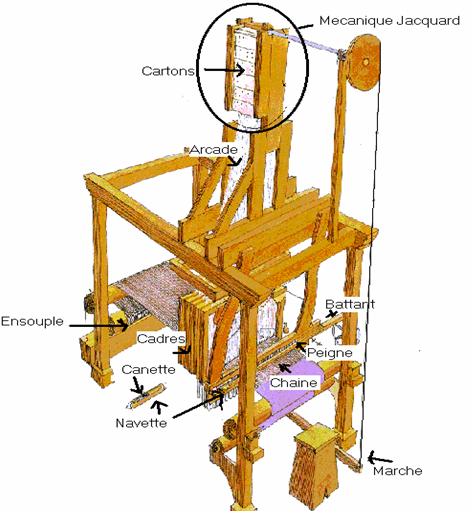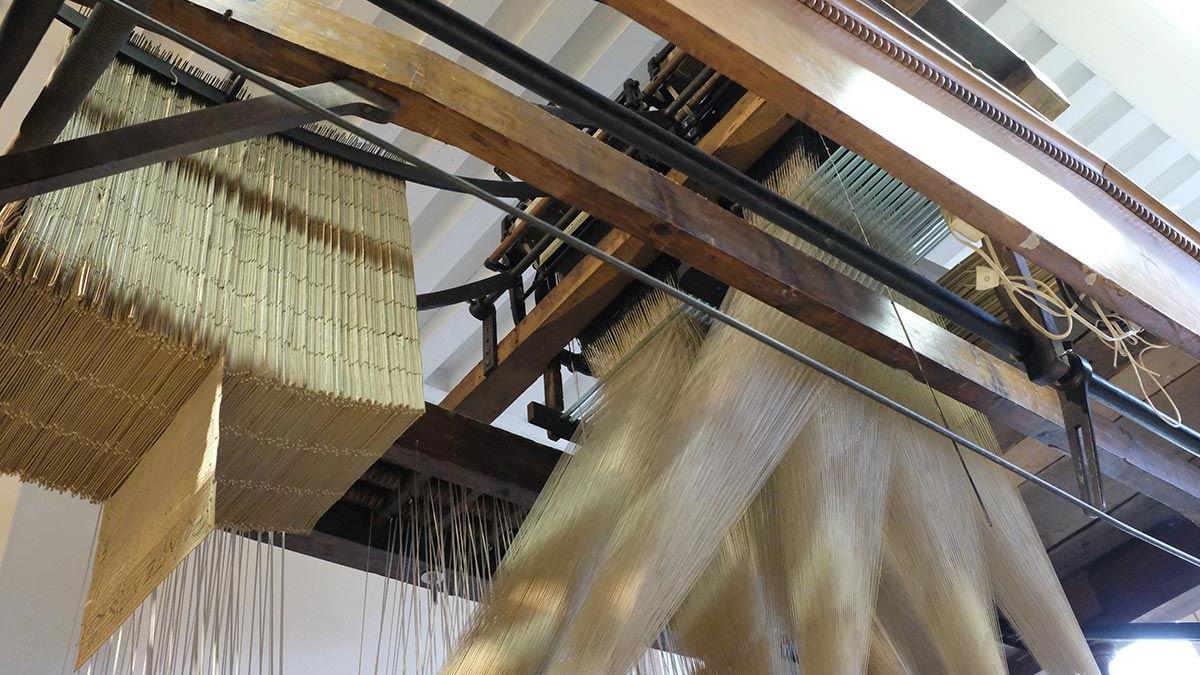 The weaving technique
The weaving technique
The production of a fabric is carried out by the interweaving of threads: longitudinal warp threads, stretched from front to back of the loom and which constitute the framework of the fabric, and a transverse weft thread, distributed by a bobbin, which is transported by a shuttle launched from one side of the loom to the other.
The way in which the threads are intertwined is called weave, the three fundamentals of which are taffeta weave (the simplest: we separate the even threads from the odd threads to open a passage for the shuttle), twill weave, and satin weave.
 The handloom
The handloom
On this loom, the weaver has a step, which, when pushed by the foot, lifts part of the warp threads (the even threads, for example) via the beams (frames lifting the threads), by means of a Jacquard mechanism.
Between the 2 layers of warp threads thus separated, a passage, the step or the crowd, has opened, in which the weaver manually launches the shuttle with the "button" connected to cords. Then, he pulls a wooden clapper fitted with a comb, which compacts the weft thread he has just inserted against the previous one and ensures the cohesion of the weaving.
All the movements of the weaver can be identified in the famous formula of Bistanclac or Bistanclac-Pan:
- BIS: the foot lifts the wires
- TAN-CLAC: the shuttle makes its way (or back)
- PAN: The flap hits the weave.
Each thread of the warp is passed through an eyelet (sometimes called a "cockroach"), connected to a link attached to a vertical arch attached to a hook of the mechanics.
Each hook is attached to a needle responsible for reading the cardboard that is placed in front of it:
- If the needle is placed in front of the hole in the cardboard, it moves forward and the hook is lifted by a knife, causing the corresponding warp thread to lift.
- if the needle hits a solid part of the cardboard, the hook remains in place and does not lift the thread.
The rotating cardboard is advanced once more until the pattern is complete, and then the whole process is repeated automatically in a never-ending motion. It takes around thirty of these ‘strokes’ to make 1 centimetre of fabric, and we can hit up to 100 strokes per minute, producing around 5 metres of single fabric per day.
 The Jacquard Mechanism
The Jacquard Mechanism
The Jacquard mechanism, named after the famous Lyon inventor (originally 1801), solves the problem by a set of hooks, which support the warp threads by means of several thousand (arcade) ropes; Only the threads supported by the hooks that pass through the perforations of an unrolling perforated cardboard, which has been prepared taking into account the patterns and colours of the fabric, are lifted...
 The "chameleon"
The "chameleon"
weave
The so-called chameleon fabric is a taffeta animated by changing reflections, because the weaving involves 3 colors: 1 for the warp and 2 for the wefts; The shuttle has 2 bobbins, which deposit 2 strictly parallel wires. This requires the weaver to be very reliable and precise... This profession is devoid of any mechanism.
 Shaped weaving
Shaped weaving
Shaped weaving (Damas de Lyon, Lampas, etc.) is more complex and is based, for the looms we present, on the use of a Jacquard mechanism, which surmounts the loom (which reaches at least 4 meters in height). It was therefore necessary to create a perforated cardboard from the drawing to be reproduced, which controls the lifting of the warp threads by means of the mechanism. Each thread of the warp is passed through an eyelet or cockroach, connected to a link attached to a vertical arch attached to a hook of the mechanism.
The majority of the trades we present, including those in the trimmings workshop, are of this type.
 Trimming
Trimming
It involves making narrow pieces (ribbons, braids,...). We combine (online) a dozen mini-looms (with warp, weft, shuttle and cardboard) all working at the same time. The richness of the materials used (gold or silver sheathed wires) adds to the quality of the product. One can imagine how vigilant the trimmer must be if he produces 16, 32, or 48 stripes at the same time, if he has 1, 2 or 3 looms, as was the case in the trimmings workshop. The electrical equipment attached to old handlooms makes the work less arduous, but requires increased supervision.